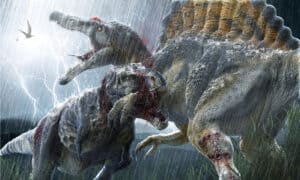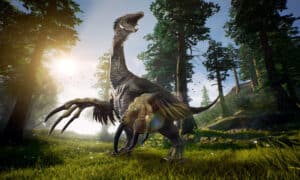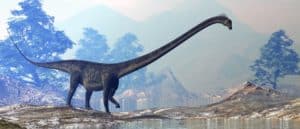Although it may be hard to imagine, Massachusetts was once the home to dinosaurs. This state was not home to as many different species of dinosaurs as Utah, Montana, or other western states. Still, paleontologists have identified enough fossils in this area to name a state dinosaur, something we’ll get to later. For now, we’re going to tell you all about the four confirmed dinosaurs that lived in Massachusetts.
We’ll also tell you where you can see dinosaur fossils of these specimens and others in the state. Get ready to learn about the cool creatures that once stomped around the Bay State.
What Are the 4 Dinosaurs that Lived in Massachusetts
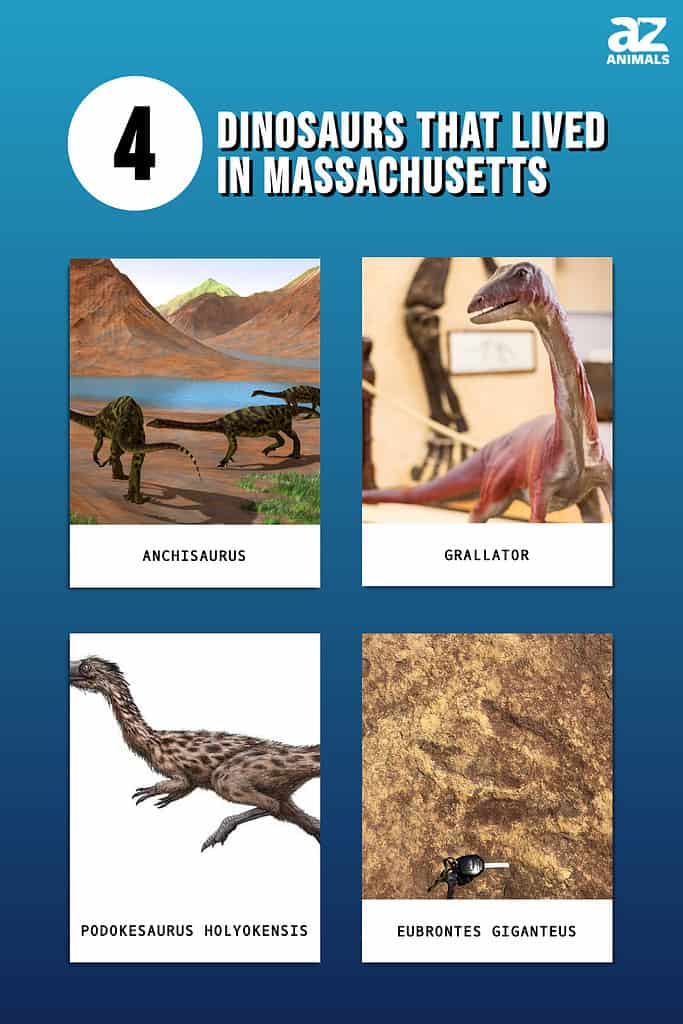
We’re going to examine four dinosaurs that lived in this particular state. These may not have been all the dinosaurs that lived in the state, though. When paleontologists gather data from fossilized remains, things can get confusing. Sometimes, they find fossilized bones. Yet, they only found bones from two species, Podokesaurus holyokensis and Anchisaurus polyzelus.
Other times, scientists find footprints proving that dinosaurs traveled through an area. Footprints are a valuable type of remains, but they don’t always lend themselves to determining which particular species traveled through an area, like Grallator. Nevertheless, paleontologists have found that at least four types of dinosaurs lived in Massachusetts. Other dinosaurs probably lived in the area too.
So, without further ado, let’s take a look at the dinosaurs that lived in this state!
1. Anchisaurus
Anchisaurus represents a genus of small, herbivorous, sauropodomorphs that grew about 6.6 feet long and weighed perhaps 60 pounds. The fossil’s size made some people believe they were human remains! The dinosaur walked on four legs, but it could still rear back on its hind legs to reach higher plants.
Anchisaurus lived during the Early Jurassic, roughly 200 million years ago. The remains of this dinosaur were discovered in the Portland Formation, a geological formation in Connecticut as well as Massachusetts.
The remains of Anchisaurus were discovered in Springfield, Massachusetts in the year 1855. Unfortunately, the fossils were discovered during a construction project. The specimens were badly damaged before they were ultimately recovered.
These days, you can see the original type specimen of the Anchisaurus polyzelus at the Beneski Amherst College Museum of Natural History.
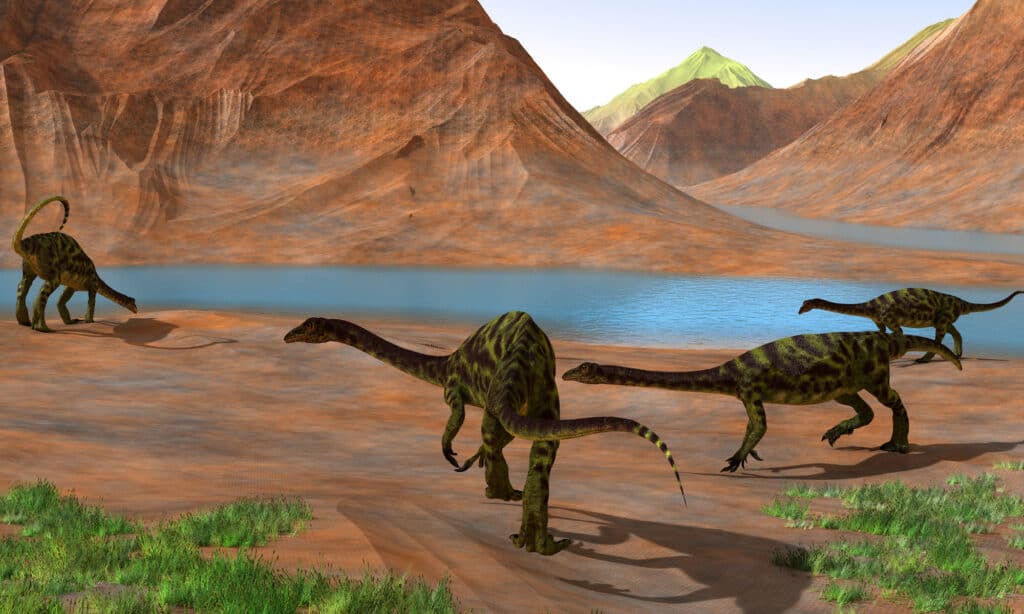
Anchisaurus walked on four legs, but it could still rear back on its hind legs to reach higher plants.
©iStock.com/CoreyFord
2. Grallator
The evidence of the Grallator ichnogenus is based on fossilized footprints found throughout the Connecticut River Valley trackways. The footprints were found throughout the sandstone beds in Massachusetts and other surrounding states.
The dinosaurs in this group were small therapods. Their footprints measured about 4 to 8 inches long and featured three toes even though the dinosaurs probably had short, stubby toes that would not touch the ground while they were moving. They probably only grew a few feet tall.
Scientists dated these footprints back to the Early Triassic or Early Jurassic periods. Members of Grallator are very widespread, and they are found throughout several continents.
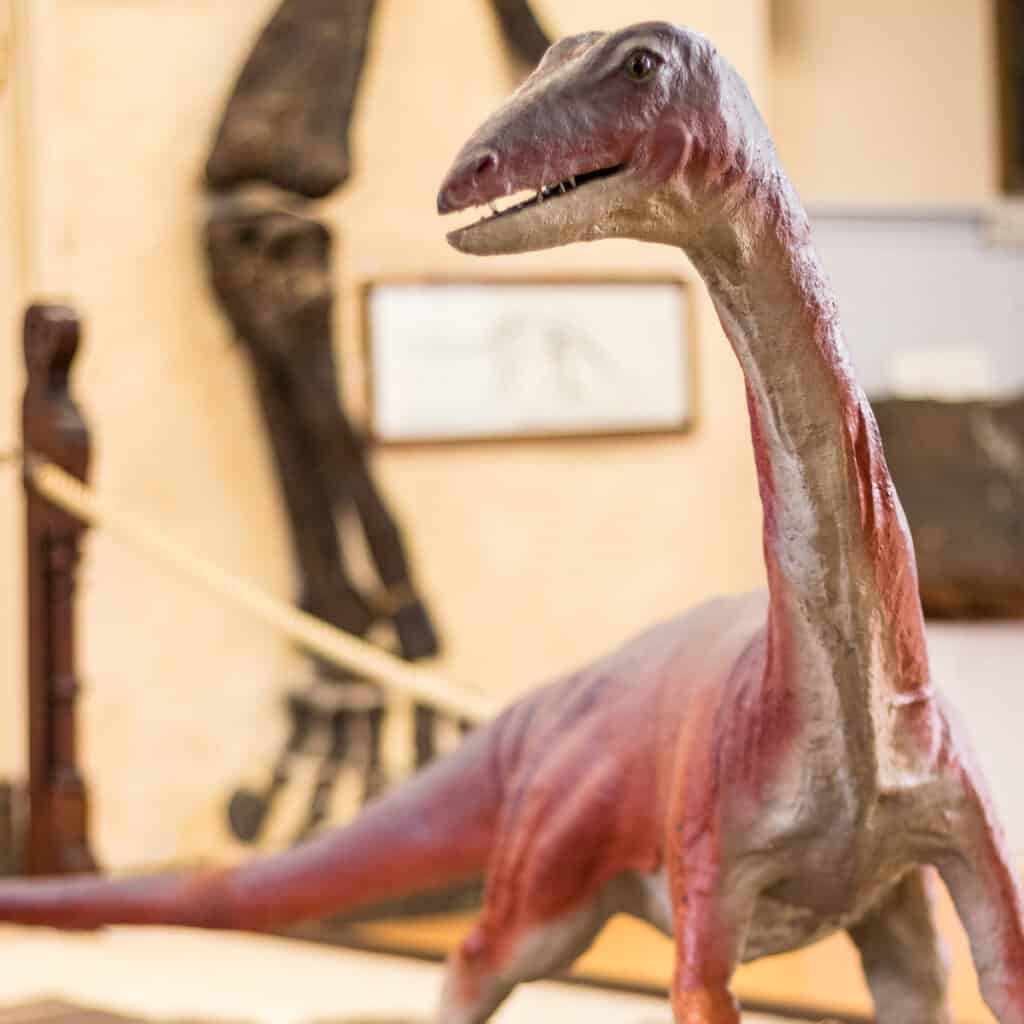
The evidence of the
Grallatoris based on fossilized footprints, some of which were found throughout the sandstone beds in Massachusetts.
©Benjamin Clapp/Shutterstock.com
3. Podokesaurus holyokensis
Mignon Talbot found Podokesaurus holyokensis fossils in 1910 in a place called Mount Holyoke. The location of the dinosaur influenced its name, but the full translation would be something akin to the swift-footed lizard of Holyoke. The dinosaur was small and bipedal, measuring about 3 feet long and weighing anywhere up to 90 pounds.
Of course, paleontologists have to recover and examine more fossil remains before they determine the actual size of the creature. As it stands, the original fossils from this species were incomplete. However, the remains included neck bones, tail bones, shoulder blades, thigh bones, and more.
Scientists learned a great deal about this dinosaur from these remains. Sadly, you won’t find the original fossils of this specimen found in Massachusetts. The fossils were kept at Williston Hall at Mount Holyoke, and the building burned down in 1917, leaving no traces of the remains that had once existed.
That means this dinosaur had the misfortune of going extinct, being rediscovered, and then destroyed again when its fossils were lost.
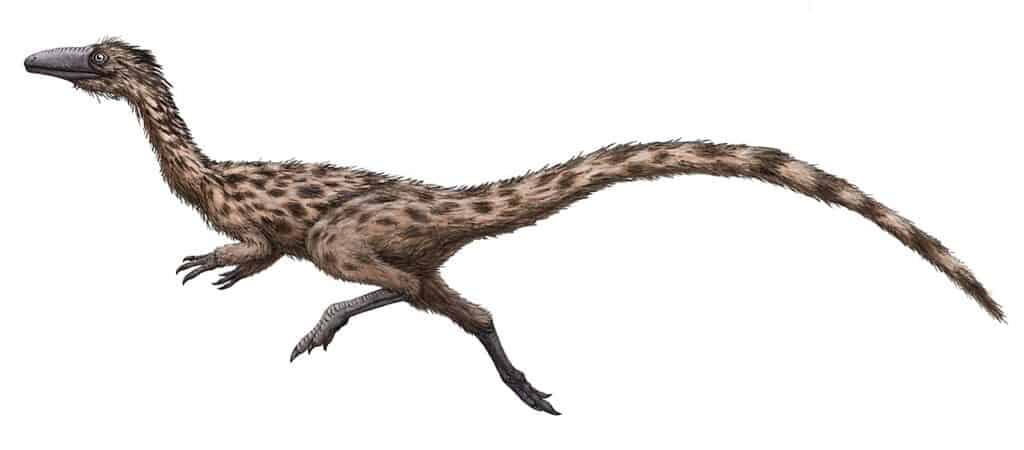
fossils were found in 1910 in Mount Holyoke, Massachusetts.
©FunkMonk (Michael B. H.) / CC BY-SA 3.0 – License
4. Eubrontes giganteus
Trace fossils of Eubrontes giganteus suggest that it was far larger than any of the other dinosaurs in Massachusetts. Unlike the diminutive Anchisaurus, Eubrontes giganteus may have measured almost 30 feet long and weighed up to 1,300 pounds. This biped may have been over 3 feet tall at its hips.
The dinosaur had very large footprints that measured almost 20 inches, and they are still visible to this day. The footprints of the Eubrontes giganteus were also discovered in the Connecticut River Valley in the western portion of Massachusetts.
Over 600 additional footprints were discovered in Connecticut, a place that is now called Dinosaur State Park.
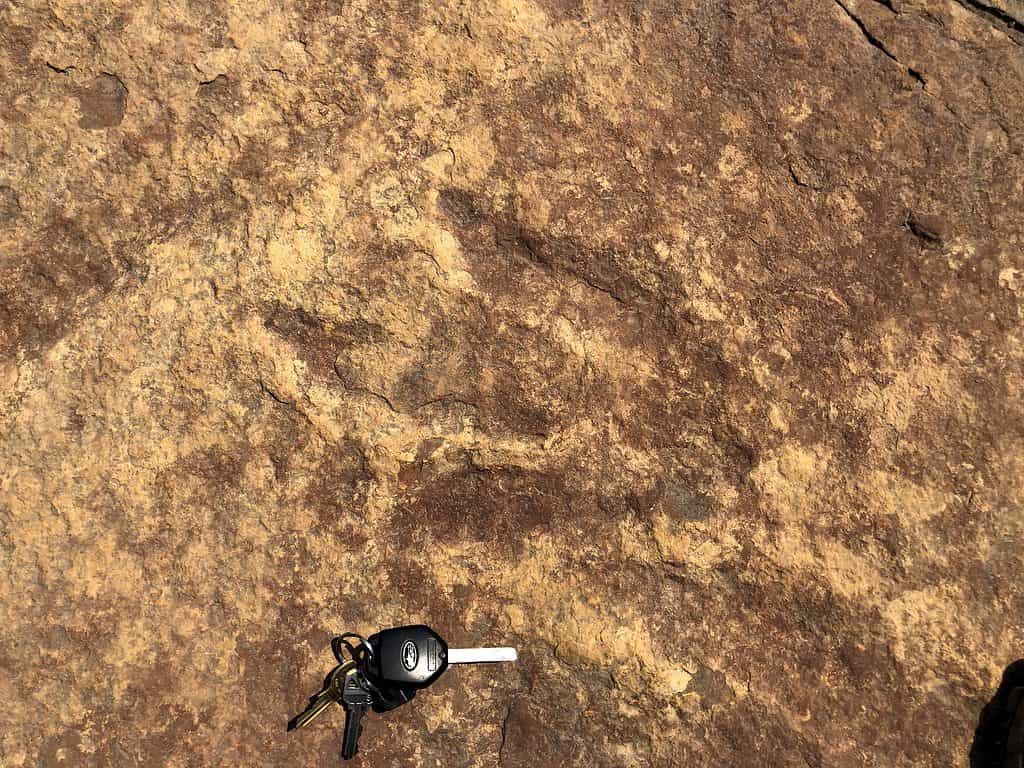
footprints indicate that they were larger than any of the other dinosaurs in Massachusetts.
©Carpenter, Kenneth, CC BY-SA 4.0 <https://creativecommons.org/licenses/by-sa/4.0>, via Wikimedia Commons – License
What Is Massachusetts’ State Dinosaur?
Podokesaurus holyokensis is Massachusetts’ state dinosaur. This creature lived during the Early Triassic Period. A geologist named Mignon Talbot found the first fossils of this dinosaur in Mount Holyoke, Massachusetts, and that helped inform the creature’s name.
The creature was named the state dinosaur in 2021 after an online vote with 35,000 respondents. This was a small dinosaur that weighed perhaps anywhere between 2 and 90 pounds. Scientists know that it only measured about 3 feet in length, so it was not a very large creature.
Where Can You See Dinosaur Fossils in Massachusetts?
If you would like to see dinosaur fossils in Massachusetts, you’ll need to go to some of the museums and universities. As we’ve already mentioned, you can see actual fossils at Beneski Amherst College Museum of Natural History.
You can also visit Holyoke, Massachusetts and see the dinosaur tracks for yourself. Officially, the area is called the Dinosaur Footprints Reservation. This park covers about 8 acres of land. The area is open from April until November. However, it’s a good idea to familiarize yourself with park rules and to treat every part of the park with the utmost respect.
Now you know what dinosaurs lived in Massachusetts, how long ago they lived, and where you can see some of their remains!
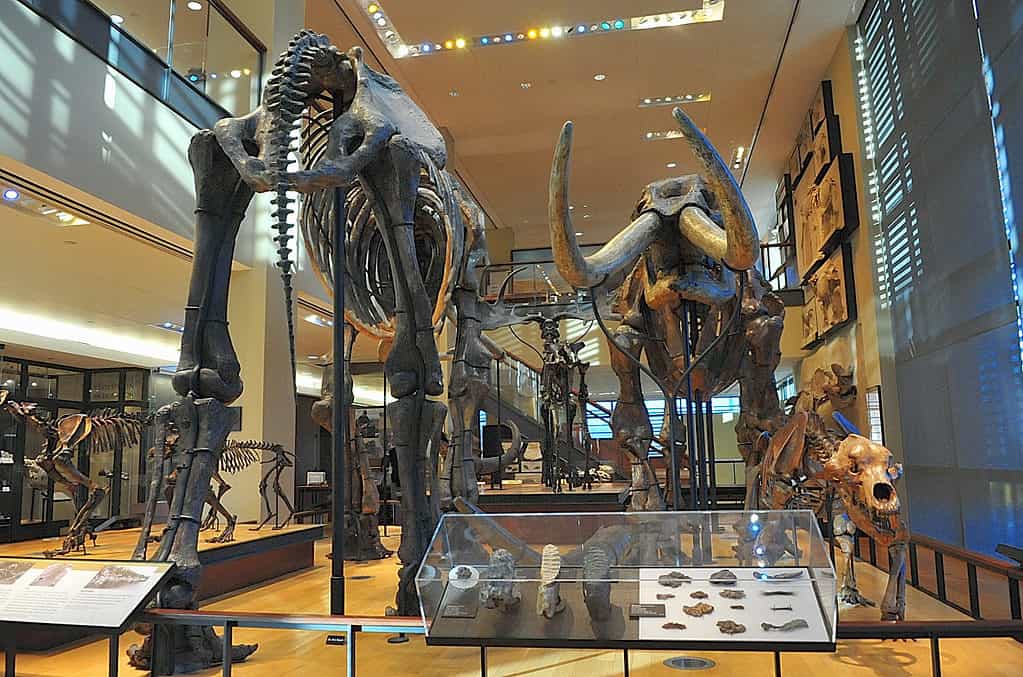
The Beneski Museum of Natural History, Amherst College in Massachusetts showcases a wide range of fossils collected locally.
©Richard Haddad / Flickr – License
Up Next
- Discover 8 Extinct Animals That Lived in Nevada
- Top 10 World’s Largest Dinosaurs Ever
- 14 Dinosaurs that Lived in Texas (And Where to See Fossils Today)
- Dinosaurs that Lived in Kentucky (And Where to See Fossils Today)
- 6 Dinosaurs that Lived in Idaho (And Where to See Fossils Today)
The photo featured at the top of this post is © JERRYE AND ROY KLOTZ MD, CC BY-SA 3.0
Sources
- National Public Radio, Available here: https://www.npr.org/2022/10/19/1130024340/massachusetts-state-dinosaur
- Smithsonian, Available here: https://www.smithsonianmag.com/smart-news/massachusettss-official-state-dinosaur-180976965/
- The Trustees, Available here: https://thetrustees.org/place/dinosaur-footprints/
Thank you for reading! Have some feedback for us? Contact the AZ Animals editorial team.



